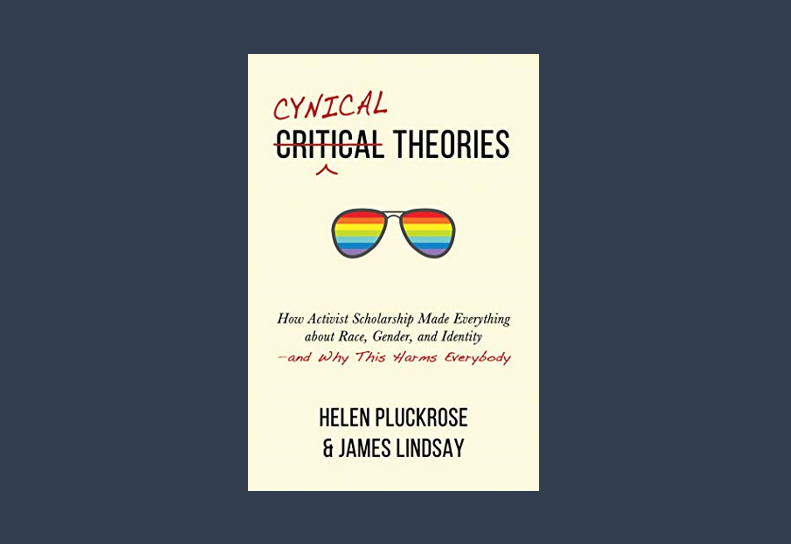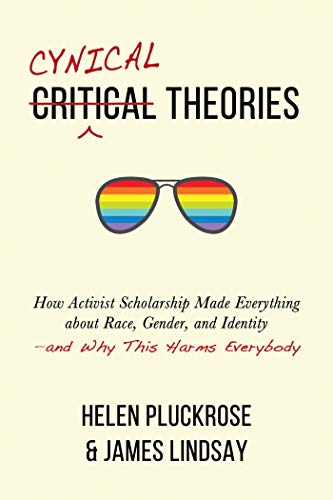
Cynical Theories: How Activist Scholarship Made Everything about Race, Gender, and Identity – and Why This Harms Everybody, is a recently published book by Helen Pluckrose and James A. Lindsay. To briefly introduce the book, it tries to unpack the social phenomena of feminism, racism, LGBTQ, disability, and fat studies. The authors approach these topics from a historical point of view and discuss philosophical figures and ideals that have contributed to the rise in the waves of activism we see in the present day. They start off discussing (applied) postmodernism which sets the tone for the rest of the book. Throughout the book, they focus on the idea that the power we bestow on language is a construct that arose from postmodernism – whereby postmodernism is based on two principles: ‘Radical skepticism about whether objective knowledge or truth is attainable and a commitment to cultural constructivism’ and ‘A belief that society is formed of systems of power and hierarchies, which decide what can be known and how.’
The authors believe that the idea, that language is powerful and important in influencing our identities, should not be applied to reality. For instance, the use of politically correct language and the importance of people’s preferred pronouns. They seem to suggest that ‘modern-day problems’ like racism arose because of this application, whereby we are ‘advocating a particular ought than attempting a detached assessment of is.’ They believe that the achievement of legal equality (regarding race, gender, and sexuality) is where we should draw the line and pat ourselves on the back for a job well done. In their view, equality has already been restored, and going further than this ‘produce[s] diminishing returns.’ However, what the authors fail to see is that these problems of social inequality (some of which are products of legal inequality) were already in existence and are only recently coming to light because of our evolved thinking and reappraisal of the situation. For instance, the idea that that onus of rape lies on women and the way they dress instead of men taking responsibility for sexual assaults. This shift of blame is quite subtle and might have been overlooked previously but it is clear from the ‘solutions’ formulated – ‘the girl should not have walked alone late at night’ or ‘women should dress more modestly’ – that women are given unfair treatment in such social discussions.
In general, this book is a rather biased narration littered with cherry-picking and straw-man arguments. For instance, to ‘give weight’ to their argument that homosexuality is ‘something people did rather than who they were’, the authors used the example that, in Ancient Greece, men engaged in sexual acts with young boys till they were old enough to get married. This example is not only a false representation of homosexuality – of it being a choice and the idea that it is merely a physical act – but also creates an unwarranted negative association with homosexuality (paedophilia is not exclusive to one sexuality). Besides this, the authors take statements out of context, twisting ideas and removing the nuances in the process. To give just one example, they claimed that ‘We are informed that only people of color can talk about racism, that white people need to just listen, and that they don’t have the “racial stamina” to engage it.’ In reality, from my understanding, the idea is that people of colour should be given the platform, the microphone, while others take the backseat for a moment. We need more of their voices heard because they are the ones with first-hand knowledge of the racism discussed. White people are free to engage in discussions and voice their views but there are situations that a white person would not be able to speak well on, simply because they have never encountered them. Just like how someone who hasn’t given birth can try to speak about the experience of childbirth, but it would be more informative to let someone who has given birth speak about it.
Throughout the book, the arguments are a combination of (historical and theoretical) facts and the author’s version of the truth. This makes it challenging to discern fact from opinion. For instance, the authors explain the concepts of materialist and postmodern approaches to racism (facts) then proceeds to assert that the materialist view (focusing on systemic and structural racism) is being overtaken by the postmodern view (focusing on microaggression, hate speech, safe spaces, cultural appropriation, implicit association tests, and media representation; their version of the truth). What they fail to realise or choose to ignore is that these concepts are not at odds with each other. The concepts are very much complementary and intertwined. To position the argument like this is to create a false dilemma as it is not an either-or it is all part of the same movement. The ‘postmodern’ view builds upon the ideas of the ‘materialist’ view – they are layers of the same pyramid, so to speak. I can imagine that for a person unfamiliar with these social issues, it is very easy to be misled by the poor but confident arguments put forth. Personally, it was frustrating to read as I tried to understand and unpack their argument, looking for good, substantiated reasoning to support their views, only to find fallacies and hollow arguments.
It is ironic that the authors focused on the idea that modern-day activism removed ‘objective reality’ when they themselves are guilty of doing exactly that in this book. Besides the above examples, the authors painted a false picture of fat activists. That fat activists promote fat acceptance, disregarding the ‘overwhelming evidence’ that obesity can be addressed through diet/exercise, as well as the negative consequences of obesity. Based on my (limited) knowledge of fat activism, I am aware that this is not the complete or true picture. Fat activists know these facts and are not ignoring them but instead, they are advocating for the recognition of other factors contributing to obesity, like genetics and diseases. They aim to highlight the importance of treating people who are obese with respect and for doctors to take them seriously. Oftentimes, these individuals are shamed or joked about, and their (secondary) conditions are trivialised in the medical setting due to their being obese. For example, telling someone they should just exercise or eat less to lose weight and that their other health issues will go away are based on assumptions about the cause of their obesity, and the causal direction of their health conditions.
Throughout the book, it seems as if the authors are writing from the perspective of a person with no empathy for or understanding of the struggles other people face – speaking from their ivory tower of social privilege. For instance, just because the gender binary does not affect you or your identity, it does not mean that others aren’t affected by it. The authors seem to think that the idea of ‘language is power’ should be left in philosophy and not applied to everyday life. Well, language is powerful, and words can have a great impact on people and their identity (Appel & Weber, 2017). Therefore, pronouns are important. Therefore, acts of racist microaggressions cannot be ignored. Therefore, we should not fat-shame. In my opinion, the authors should read up on more scientific articles and try to understand a variety of perspectives before writing a controversial book of misinformation. That said, the authors have done their research (only) with regards to the philosophical ideas and describing the phenomena they discuss. In summary, this is a book that gives you ‘easy’ excuses to stick to the norm. It may alleviate your anxiety about the changes occurring but acts as a setback to the progress made in these fields. I would recommend people to read this book with a critical eye, question the arguments suggested, and do their own research into these topics. Just because it is a published book does not mean it holds truth or knowledge.
Available at the (online) UvA library, and at your local book store or online, starting from €10,99.

Cynical Theories: How Activist Scholarship Made Everything about Race, Gender, and Identity – and Why This Harms Everybody, is a recently published book by Helen Pluckrose and James A. Lindsay. To briefly introduce the book, it tries to unpack the social phenomena of feminism, racism, LGBTQ, disability, and fat studies. The authors approach these topics from a historical point of view and discuss philosophical figures and ideals that have contributed to the rise in the waves of activism we see in the present day. They start off discussing (applied) postmodernism which sets the tone for the rest of the book. Throughout the book, they focus on the idea that the power we bestow on language is a construct that arose from postmodernism – whereby postmodernism is based on two principles: ‘Radical skepticism about whether objective knowledge or truth is attainable and a commitment to cultural constructivism’ and ‘A belief that society is formed of systems of power and hierarchies, which decide what can be known and how.’
The authors believe that the idea, that language is powerful and important in influencing our identities, should not be applied to reality. For instance, the use of politically correct language and the importance of people’s preferred pronouns. They seem to suggest that ‘modern-day problems’ like racism arose because of this application, whereby we are ‘advocating a particular ought than attempting a detached assessment of is.’ They believe that the achievement of legal equality (regarding race, gender, and sexuality) is where we should draw the line and pat ourselves on the back for a job well done. In their view, equality has already been restored, and going further than this ‘produce[s] diminishing returns.’ However, what the authors fail to see is that these problems of social inequality (some of which are products of legal inequality) were already in existence and are only recently coming to light because of our evolved thinking and reappraisal of the situation. For instance, the idea that that onus of rape lies on women and the way they dress instead of men taking responsibility for sexual assaults. This shift of blame is quite subtle and might have been overlooked previously but it is clear from the ‘solutions’ formulated – ‘the girl should not have walked alone late at night’ or ‘women should dress more modestly’ – that women are given unfair treatment in such social discussions.
In general, this book is a rather biased narration littered with cherry-picking and straw-man arguments. For instance, to ‘give weight’ to their argument that homosexuality is ‘something people did rather than who they were’, the authors used the example that, in Ancient Greece, men engaged in sexual acts with young boys till they were old enough to get married. This example is not only a false representation of homosexuality – of it being a choice and the idea that it is merely a physical act – but also creates an unwarranted negative association with homosexuality (paedophilia is not exclusive to one sexuality). Besides this, the authors take statements out of context, twisting ideas and removing the nuances in the process. To give just one example, they claimed that ‘We are informed that only people of color can talk about racism, that white people need to just listen, and that they don’t have the “racial stamina” to engage it.’ In reality, from my understanding, the idea is that people of colour should be given the platform, the microphone, while others take the backseat for a moment. We need more of their voices heard because they are the ones with first-hand knowledge of the racism discussed. White people are free to engage in discussions and voice their views but there are situations that a white person would not be able to speak well on, simply because they have never encountered them. Just like how someone who hasn’t given birth can try to speak about the experience of childbirth, but it would be more informative to let someone who has given birth speak about it.
Throughout the book, the arguments are a combination of (historical and theoretical) facts and the author’s version of the truth. This makes it challenging to discern fact from opinion. For instance, the authors explain the concepts of materialist and postmodern approaches to racism (facts) then proceeds to assert that the materialist view (focusing on systemic and structural racism) is being overtaken by the postmodern view (focusing on microaggression, hate speech, safe spaces, cultural appropriation, implicit association tests, and media representation; their version of the truth). What they fail to realise or choose to ignore is that these concepts are not at odds with each other. The concepts are very much complementary and intertwined. To position the argument like this is to create a false dilemma as it is not an either-or it is all part of the same movement. The ‘postmodern’ view builds upon the ideas of the ‘materialist’ view – they are layers of the same pyramid, so to speak. I can imagine that for a person unfamiliar with these social issues, it is very easy to be misled by the poor but confident arguments put forth. Personally, it was frustrating to read as I tried to understand and unpack their argument, looking for good, substantiated reasoning to support their views, only to find fallacies and hollow arguments.
It is ironic that the authors focused on the idea that modern-day activism removed ‘objective reality’ when they themselves are guilty of doing exactly that in this book. Besides the above examples, the authors painted a false picture of fat activists. That fat activists promote fat acceptance, disregarding the ‘overwhelming evidence’ that obesity can be addressed through diet/exercise, as well as the negative consequences of obesity. Based on my (limited) knowledge of fat activism, I am aware that this is not the complete or true picture. Fat activists know these facts and are not ignoring them but instead, they are advocating for the recognition of other factors contributing to obesity, like genetics and diseases. They aim to highlight the importance of treating people who are obese with respect and for doctors to take them seriously. Oftentimes, these individuals are shamed or joked about, and their (secondary) conditions are trivialised in the medical setting due to their being obese. For example, telling someone they should just exercise or eat less to lose weight and that their other health issues will go away are based on assumptions about the cause of their obesity, and the causal direction of their health conditions.
Throughout the book, it seems as if the authors are writing from the perspective of a person with no empathy for or understanding of the struggles other people face – speaking from their ivory tower of social privilege. For instance, just because the gender binary does not affect you or your identity, it does not mean that others aren’t affected by it. The authors seem to think that the idea of ‘language is power’ should be left in philosophy and not applied to everyday life. Well, language is powerful, and words can have a great impact on people and their identity (Appel & Weber, 2017). Therefore, pronouns are important. Therefore, acts of racist microaggressions cannot be ignored. Therefore, we should not fat-shame. In my opinion, the authors should read up on more scientific articles and try to understand a variety of perspectives before writing a controversial book of misinformation. That said, the authors have done their research (only) with regards to the philosophical ideas and describing the phenomena they discuss. In summary, this is a book that gives you ‘easy’ excuses to stick to the norm. It may alleviate your anxiety about the changes occurring but acts as a setback to the progress made in these fields. I would recommend people to read this book with a critical eye, question the arguments suggested, and do their own research into these topics. Just because it is a published book does not mean it holds truth or knowledge.
Available at the (online) UvA library, and at your local book store or online, starting from €10,99.




